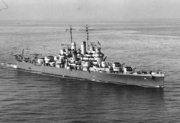Cleveland class cruiser
|
|
The United States Navy designed the Cleveland class of light cruisers for World War II with the goal of increased range and AA armament as compared with earlier classes.
Although 39 ships were projected to be built, only 27 were actually commissioned. The Cleveland class is the most successful cruiser class in history (tied with the Ticonderoga-class guided missile cruiser).
The ships were mainly used in the Pacific during World War II, some however saw action in Europe and off of the coast of Africa.
Statistics
- Displacement:
- Standard: 11800 tons
- Full: 14131 tons
- Length: 186.0 meters
- Beam: 20.2 meters
- Draught: 7.5 meters
- Height (Mast): 34.5 meters
- Crew (Officers/Men): 70/1285
- Speed: 32.5 knots
- Armament:
Ships
- Cleveland (CL-55)
- Columbia (CL-56)
- Montpelier (CL-57)
- Denver (CL-58)
- Santa Fe (CL-60)
- Birmingham (CL-62)
- Mobile (CL-63)
- Vincennes (CL-64)
- Pasadena (CL-65)
- Springfield (CL-66)
- Topeka (CL-67)
- Biloxi (CL-80)
- Houston (CL-81)
- Providence (CL-82)
- Manchester (CL-83)
- Vicksburg (CL-86)
- Duluth (CL-87)
- Miami (CL-89)
- Astoria (CL-90)
- Oklahoma City (CL-91/CLG-5)
- Little Rock (CL-92)
- Galveston (CL-93)
- Youngstown (CL-94)
- Amsterdam (CL-101)
- Portsmouth (CL-102)
- Wilkes-Barre (CL-103)
- Atlanta (CL-104)
- Dayton (CL-105)
Source
- Statistics (http://www.microworks.net/pacific/ships/cruisers/cleveland.htm)
| Cleveland-class cruiser |
| Cleveland | Columbia | Montpelier | Denver | Santa Fe | Birmingham | Mobile | Vincennes | Pasadena | Springfield | Topeka | Biloxi | Houston | Providence | Manchester | Vicksburg | Duluth | Miami | Astoria | Oklahoma City | Little Rock | Galveston | Amsterdam | Portsmouth | Wilkes-Barre | Atlanta | Dayton |
| List of cruisers of the United States Navy |

